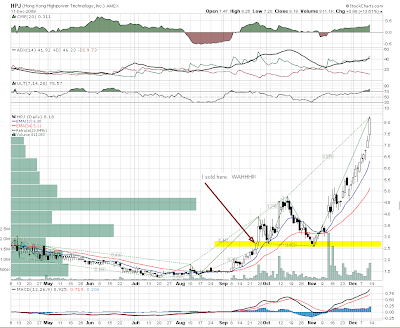[Here's another re-tread (edited)post from my blog. I wrote this post after Market Sniper offered some thoughtful commentary when I was lamenting this blown trade on HPJ. I also received some terrific technical help on a TOS program from both Viscous and Greg. Offering this 're-tread' is way to highlight the community hear and the cult of shared learning.]
It's not enough to find a stock in which to take a position, but it
is also important to manage the position to optimize results (maximize profits! minimize losses!!!). The literature tells us to
keep our losses small and let our winners run. Sound advice. However,
when faced with a loss, our head often counsels this way: "If you hold onto this stock, it will
come back!" Conversely, when faced with a gain our head has equally pathetic counsel: "Better to
sell it now…you know what they say, 'nobody goes broke pocketing a
gain.' Besides you big dummy look at those losers in your portfolio–be
quick before this turns into one of those."
It's worth
remembering that your mind really doesn't have a mind of its own; and it is quite adept at offering supportive rationalizations for any of your lesser inspired inclinations. You can go broke by failing to take a gain. How? Simply by hanging onto
your losers while tripping up your winners (selling them) after they've made it
through the first turn on their track to unknown price heights. All of this is a reminder that we must first master our own psychology–and poor disciplines rob us of the psychic energy that we need to trade successfully.
Enough sermonizing…….. Let's
take a look at one of my winning horses, HPJ that I shot dead just after it made its first turn in its personal Kentucky Derby. I identified it as a volatility squeeze (VS) play. To find targeted stocks, I'll set Keltner Channel and Bollinger Bands to 10 periods and filter for stocks that have the Bollinger Bands inside the Keltner Channel. I look through hundreds of charts. I'm looking for volume patterns coupled with attractive basing patterns. HPJ fit that bill.
HPJ popped out of this VS. When my gain was 97% I couldn't stand it any longer, and I sold the whole damned thing. It tripped (read consolidated); and I shot it. Why? Because my mind (which has no mind) got very chatty and started yammering about how HPJ had lingered a wee bit too long (to my eye) for a
follow through in volume on the initial breakout. I sold it. Within 15 minutes, the stock rocketed obscenely higher. I use this VS 'strategy' regularly. Because I had not codified this strategy , it was merely an idea rattling around in my head. Businesses don't confuse ideas with strategy, nor should we as traders. Failing to codify that idea into a cogent strategy was expensive.
It is important to differentiate
between hindsight bias and transforming 'coulda, woulda, shoulda's'
into learning vehicles. What would my learning be from this trip down
memory lane? Let's see how I could I could have managed this trade more effectively (as I have managed others like this) with a strategy. Here's the chart (It went on to more than $9.5).
(click to make larger)
- On first volatility breakout, sell 1/2 position (these are generally large moves > 30%)
- On subsequent pullback (price and volatility), rebuy 1/2 position–now back to full position.
- On
second breakout, I sell 1/2 position again, and looked for
another entry (pullback to a trendline) if one presents itself. As you can see from the chart, that is what some other
eyeballs were looking for. - I would have sold 2 of 3 tranches into the melt up and kept 1/3 position–managing that against a trailing stop loss percentage. [Note: Market Sniper's counsel was to keep a running position, and that he has many of those.]
Now
plenty of folks keep buying into these melt ups. I'm already in the position at a low risk entry, so I don't do that. My DNA is not wired
that way–not on these speculative stocks which can pop and drop rather
quickly. It's important to be in tune with your own risk tolerances and trading preferences.
The above playbook was soft in that it was rolling around in my head, not solidified by committing it to paper. Since I've committed it to paper, I've treated it as a core discipline with good results. I hope this post inspires newer traders to commit their learnings to paper and review and revise as necessary. As always all position sizes should be managed prudently within your risk tolerances.
Position: (1) Lamenting HPJ – the one that got away and went up, up and away | (2) Grateful to be part of a community and to have members who willingly teach and serve as sounding boards.


